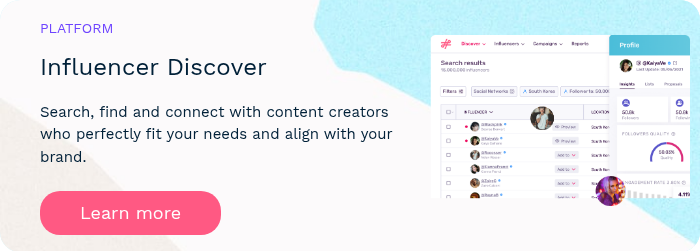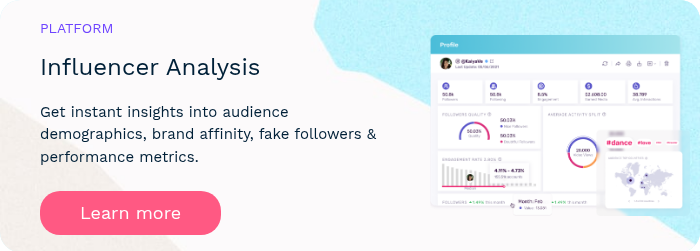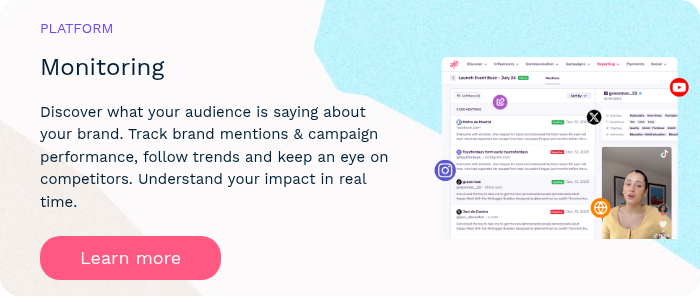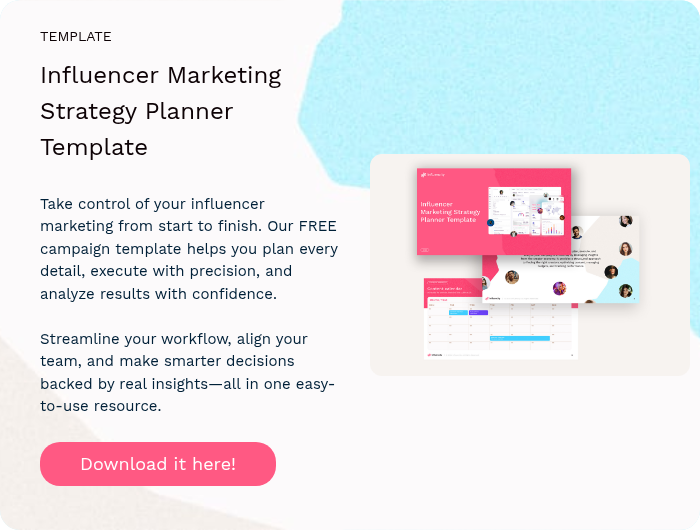23 min read
August 10, 2022
Aug 5, 2025
The 5 Influencer Marketing Tool Essentials for Smarter, More Effective Campaigns
Written by: Influencity
How an Influencer Marketing Tool Can Help You Build a Stronger Brand Presence
Influencer marketing continues to grow in popularity, with increasing numbers of brands relying on influencer collaborations to promote their marketing campaigns. This is partly because studies have shown that 92% of consumers trust recommendations from people they know, and 70% trust the experiences of their peers. In fact, the right influencer can bring in up to 200% more profit to your campaigns.
One way to guarantee that you are getting the most from your campaigns is to make sure you are using the right influencer marketing tools. This includes basics like search engines and influencer databases, as well as more advanced influencer marketing tools such as audit, tracking, and reporting tools. The right tools can help you find relevant influencers, form partnerships, and measure the success of campaigns.
Let’s explore these tools in a bit more detail and discuss how an all-in-one platform like Influencity can streamline the process and make your life so much easier.
Search Engine, The Influencer Marketing Tool That Starts It All
A search engine might be the most basic influencer marketing tool we’re going to talk about today — but don’t let “basic” fool you. Just like Google changed how we search for answers, influencer search engines are changing how brands discover creators who actually connect with their audience. Think of it as your compass in a sea of content — one that points straight to the voices that matter for your brand.
At its core, an influencer search engine helps you find content creators across platforms like Instagram, TikTok, and YouTube. You enter your criteria — maybe you’re looking for a lifestyle influencer in Austin, Texas, who shares daily routines, home decor ideas, and healthy recipes with a loyal audience — and voilà: a curated list of potential partners appears.
While many platforms let you search using basic KPIs like location, follower count, or engagement rate, the more advanced ones go further. This type of influencer marketing tool allows you to filter by interests, audience demographics, brand affinities, content category, language, and even aesthetic style. The result? A far more intentional shortlist that actually makes sense for your campaign.

It’s kind of like online dating — but instead of swiping right on a cute profile, you’re filtering for creators who share your brand’s values and can genuinely speak to your target audience. Once you’ve set your filters, browse the results and start digging in. Scroll through their posts, skim their captions, and watch how they talk to their community. Do they come across as authentic? Do they collaborate selectively? Can you imagine your product fitting naturally into their world?
A great influencer marketing tool won’t just spit out a list of names — it’ll help you interpret the context behind the metrics. For example, a creator with 15K highly engaged followers in a niche community can drive more impact than a generic profile with half a million passive viewers.
Once you’ve found a few solid candidates, the next step is to add them to your Influencer Relationship Management (IRM) platform — another essential influencer marketing tool if you’re planning to scale your efforts. This is where you organize communication, track campaign progress, and start laying the foundation for long-term collaboration.
In short, the search engine is your entry point. It’s the influencer marketing tool that helps you stop guessing and start connecting — thoughtfully, efficiently, and strategically.
Influencer Relationship Management (IRM), The Influencer Marketing Tool That Keeps All Your Collabs on Track
An IRM — short for Influencer Relationship Management — is like an influencer database, but on a serious upgrade. It’s not just about storing names and email addresses; it’s about managing real relationships with the people who represent your brand out in the wild.
No sales team would dream of working without a CRM, right? The same goes for influencer marketing. If you’re running more than one campaign or working with multiple creators, trying to manage everything manually becomes a chaotic mess of spreadsheets, scattered emails, and forgotten DMs. That’s where an IRM steps in as an essential influencer marketing tool.

Just as a CRM allows a sales team to centralize all of their information and keep everyone up to date, an IRM is your go-to hub for organizing influencer metrics, campaign history, rates, content performance, and contact info — all in one place. It’s where “organized chaos” becomes just “organized.”
Let’s say you’re juggling five different lifestyle influencers, all posting at different times, with unique deliverables, and their own rate cards. You could go old-school and try to manage that with color-coded docs and frantic inbox searches... or you could just open your IRM and have it all there — tracked, tagged, and updated in real time.
You can negotiate rates, track deliverables, log communication, and see who’s under contract and who’s ghosting you — all without ever leaving the platform. And that’s the beauty of using an influencer marketing tool that’s built for relationship management: it doesn’t just help you execute campaigns; it helps you build continuity.
The best part? Real-time performance data. No more updating cells in a spreadsheet while sipping cold coffee at 11 p.m. You’ll see how each influencer’s content is performing as it happens — impressions, engagement, clicks — allowing you to optimize mid-campaign instead of doing a post-mortem when it’s too late.
Audit Tool, The Influencer Marketing Tool for Real Audience Insights
A good audit tool is another valuable weapon in your arsenal — and honestly, one of the most underrated types of influencer marketing tool out there. Before you commit budget, time, and creative energy to a collaboration, you want to be sure you’re partnering with someone who’s the real deal.
This influencer marketing tool helps you take a deep dive into a creator’s profile, looking beyond follower count and aesthetics to understand who their audience is and how they engage. You’ll get insights into where their followers are from, what languages they speak, their age brackets, and — perhaps most importantly — whether those followers are authentic or artificially inflated. In an era where bots and fake engagement are still very much a thing, this level of transparency is gold.

But the value of an audit tool doesn’t stop once you’ve chosen your influencer. In fact, it becomes even more useful after the partnership begins. This kind of influencer marketing tool allows you to continuously evaluate how well your influencer is performing during and after each campaign. Are they attracting the right audience? Is their content aligning with your brand tone and values? Are the right people actually seeing and engaging with your product?
Think of an audit tool as your campaign’s compass — constantly helping you stay on course. If something’s off, it gives you the insights you need to course-correct. Maybe it’s time to tweak your messaging, adjust the content format, or rethink the collaboration entirely. Without these insights, you’re operating in the dark.
At the end of the day, an audit tool doesn’t just analyze influencers — it empowers you to make smarter, more informed decisions. And in a field where budget and credibility are always on the line, having a trusted influencer marketing tool to verify quality and performance is not just helpful — it’s essential.
Tracking Tool, The Real-Time Influencer Marketing Tool You Can’t Skip
A tracking tool works in much the same way as an audit — but with a sharper focus on real-time campaign results. If the audit is your background check, the tracking tool is your live scoreboard. And in the world of influencer marketing, that makes it one of the most essential types of influencer marketing tool you can have.
Ultimately, it’s about finding out how well a content creator is performing and whether or not they’re actually moving the needle for your brand. Reach, engagement, traffic, conversions — a good tracking tool doesn’t just show you numbers, it tells a story. And that story helps you make better decisions, faster.
You can use this kind of influencer marketing tool to monitor the content your collaborators are posting and see exactly how it performs. Is the reach growing? Are people clicking through? Is the audience saving posts, commenting, or converting into customers? By tracking KPIs like engagement rate, impressions, click-throughs, or even direct sales, you turn intuition into data — and data into strategy.
Instead of relying on screenshots or manually chasing influencers for their performance stats (been there, done that), a proper tracking tool automates this entire process. You can compare results post-by-post, campaign-by-campaign, and identify exactly what worked and what fell flat. Did that Instagram Reel bring more traffic than the Story? Was the YouTube mention more effective than the TikTok dance challenge? You’ll know — and more importantly, you’ll be able to act on it.

Platforms like Influencity offer advanced tracking features that do exactly this: they consolidate performance data across different posts and campaigns into clean, visual reports — no more Excel chaos or scattered screenshots. This is where a tracking-focused influencer marketing tool really earns its keep: it helps you scale your strategy, measure ROI, and justify your influencer marketing budget with confidence.
To put it simply: if you’re not tracking, you’re guessing. And guessing doesn’t cut it in a results-driven world. With a solid influencer marketing tool designed for tracking, you stay in control, in the loop, and always one step ahead.
Reporting Tool, The Influencer Marketing Tool That Measures What Matters
Once you’ve conducted your audits and tracked the success of your campaigns, you reach the moment of truth: analyzing and presenting your results. Because all the strategy, creativity, and coordination in the world won’t mean much unless you can clearly measure your impact. That’s where a solid influencer marketing tool focused on reporting comes into play.
An influencer reporting tool is more than just a fancy spreadsheet — it’s your post-campaign reality check. These tools act like a social listening dashboard, offering real-time analytics that show exactly how your influencer content performed once it went live. From reach and impressions to engagement, shares, and even conversions, this kind of influencer marketing tool helps you connect the dots between your goals and your actual outcomes.

Let’s say you ran a cross-platform campaign with several lifestyle creators. A proper reporting tool doesn’t just give you isolated numbers; it shows you the full picture — which platform drove the most traffic, which influencer sparked the most engagement, and what type of content resonated best with your target audience. Without this kind of analysis, you're just guessing at what worked.
Some advanced tools, like Influencity, even let you compare results at the post, social media, and full campaign level. This makes it incredibly easy to spot patterns, benchmark performance, and refine your influencer marketing strategy moving forward — all from one central dashboard.
And let’s not forget the practical side: reporting tools also save you serious time. Instead of chasing screenshots, pulling metrics manually, and cobbling together slide decks, everything is automatically compiled into sleek, professional reports that are ready to share with your team or clients.
So whether you're managing one campaign or juggling ten, a reporting-focused influencer marketing tool is what turns your raw data into actionable insight — and your insight into measurable growth.
The All-in-one Solution
These influencer marketing tools are highly valuable, and each play a role in ensuring the success of a campaign. However, if you are using different platforms for each step of your campaign, then it’s possible that some information gets lost along the way. An alternative is using an all-in-one platform for everything. This way, all your data is centralized, and you get a clear picture of how your influencer campaigns are performing from start to finish.
For example, Influencity is an influencer marketing automation tool that helps brands and agencies manage their end-to-end influencer campaigns. It gives you a full spectrum of tools and features that help you find the right influencers, analyze their profiles, and track all the statistics and metrics you need to evaluate the performance of your campaigns. With all these influencer marketing tools at your fingertips, you can be sure you are getting the most out of your campaigns.
Other posts you might be interested in
View All Posts
Influencer Marketing
22 min read
| September 5, 2025
The Customer Engagement Strategy Behind Hailey Bieber’s Rhode Beauty Boom
Read More
Influencer Marketing
23 min read
| September 4, 2025
Celebrity Influencers in Action: How Kim Kardashian & SKIMS Built a Culture-Shaping Brand Through Community
Read More
Social Media
32 min read
| September 3, 2025






